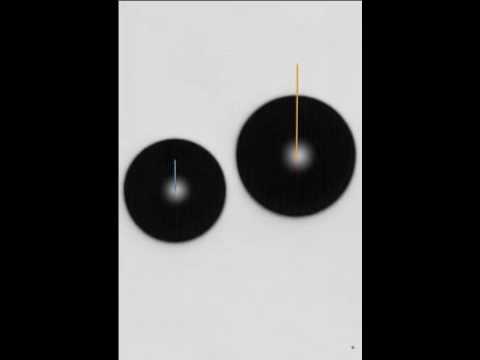Liquid drops on soft solid surfaces interact by an ‘inverted Cheerios effect’, which can be tweaked so that the droplets move towards or away from each other, according to scientists of UT’s MESA+ Institute for Nanotechnology, University of Queen Mary of London and others. They publish their findings in the journal Proceedings of the National Academy of Sciences.
The phenomenon of the famous breakfast cereal clumping together when floating in a milk bowl is known as the Cheerios effect. The ‘inverted Cheerios effect’, identified in this paper for the first time, describes a similar scenario but with the roles of liquid and solid being interchanged: liquid droplets interact when resting on a solid - but soft - surface.
In recent years, the classical Cheerios effect has inspired a new set of manufacturing technologies for advanced materials and helped physicists understanding the gravitational collapse of galaxies. Similarly, the newly discovered ‘inverted Cheerios effect’ may open up new opportunities in engineering and the life sciences.
Fogging
Tuning the movement of liquid droplets could have implications for the performance of engineering technologies which rely on drops of water and other liquids, for example. The physical phenomena highlighted in the paper suggest ways to design surfaces that prevent fogging or control heat transfer; for instance to create car windows that are always transparent despite high humidity or surfaces that improve heat management in conditioners or boilers. By making surfaces softer or harder, and changing the thickness of the soft layer, it will be possible to control how the drops coalesce and spread on the substrate.
Surface
The international team of scientists suggest the interactions of the liquid particles can be tuned to repel each other or move towards each other by changing the thickness and softness of the substrate. First author Stefan Karpitschka, who recently moved from University of Twente to Stanford University (California, USA), said: "The droplets deform the surface on which they live, and due to this deformation, they interact; somewhat reminiscent of general relativity, from which we know that galaxies or black holes interact by deforming space around them. What is remarkable about our case though is the fact that the direction of the interaction can be tuned by the medium, without modifying the particles themselves."
Cells
The implications of the effect are not limited to engineering, the researchers expect. Quantifying the forces at play when drops sit on a soft layer, will also help understanding how cells interact with each other and with the soft tissues on which they live.
The research is a joint effort of the Physics of Fluids group with the University of Queen Mary of London and other partners in The Netherlands, France and the United States.
The paper ‘Inverted Cheerios effect: Liquid drops attract or repel by elasto-capillarity’ by Stefan Karpitschka, Anupam Pandey, Luuk A. Lubbers, Joost H. Weijs, Lorenzo Botto, Siddhartha Das, Bruno Andreotti, and Jacco H. Snoeijer is published in the journal Proceedings of the National Academy of Sciences.
More recent news
 Thu 11 Dec 2025Three new NAE Fellows and Young Engineer with UT background
Thu 11 Dec 2025Three new NAE Fellows and Young Engineer with UT background Thu 11 Dec 2025Two UT projects receive Perspectief grant
Thu 11 Dec 2025Two UT projects receive Perspectief grant Fri 5 Dec 2025Transforming urban policy for a healthier and safer Enschede (and other cities)
Fri 5 Dec 2025Transforming urban policy for a healthier and safer Enschede (and other cities) Fri 28 Nov 2025UT celebrates 64th Dies: a look at the hospital of the future
Fri 28 Nov 2025UT celebrates 64th Dies: a look at the hospital of the future Fri 28 Nov 2025Van Damme scholarship for Lisa Deijlen and Wietske Woliner
Fri 28 Nov 2025Van Damme scholarship for Lisa Deijlen and Wietske Woliner

